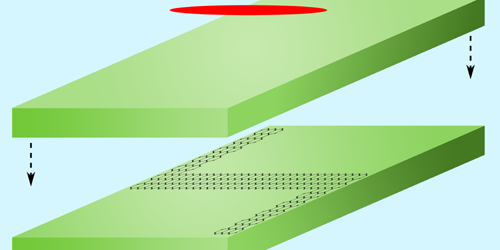Longer Trapping Expected for Graphene Atom Chips
Atom chips—devices that use electric or magnetic fields to confine and manipulate atoms—have traditionally employed metallic conductors, such as copper wires, to connect up the circuits that create the fields. Today, however, there exist more sophisticated conductors, which have been used in other devices to achieve improved performance. Mark Fromhold of the University of Nottingham, UK, and his colleagues have now predicted what it would mean if one of those conductors—in this case graphene—were to replace the metal in atom chips [1]. The team finds that the graphene-based atom chips should be able to trap atoms for more than 10 s, a period orders of magnitude longer than is possible with metal-based atom chips.
The atom chip designed by Fromhold and his colleagues consists of a Z-shaped graphene wire sandwiched between two layers of boron nitride. Passing a current through the wire induces an inhomogeneous magnetic field whose strength reaches a minimum near the center of the Z’s trunk. Ultracold atoms get trapped in this minimum.
Analyzing how the trap behaves, the team predicts that the graphene-based device is less likely than metal-based ones to “pull” atoms out of the magnetic trapping field, leading to a lower loss of atoms from the trap. The device also has a lower thermal noise—something that limits how long atoms can be held in a trap—resulting in longer trapping times. Both improvements arise, Fromhold says, because graphene wires contain fewer atoms and fewer conduction electrons than copper wires of the same size and shape: With fewer atoms and electrons, both the attractive force of the wire on the atoms and the thermal noise of the wire decrease.
–Katherine Wright
Katherine Wright is the Deputy Editor of Physics Magazine.
References
- K. Wongcharoenbhorn et al., “Using graphene conductors to enhance the functionality of atom chips,” Phys. Rev. A 104, 053108 (2021).




